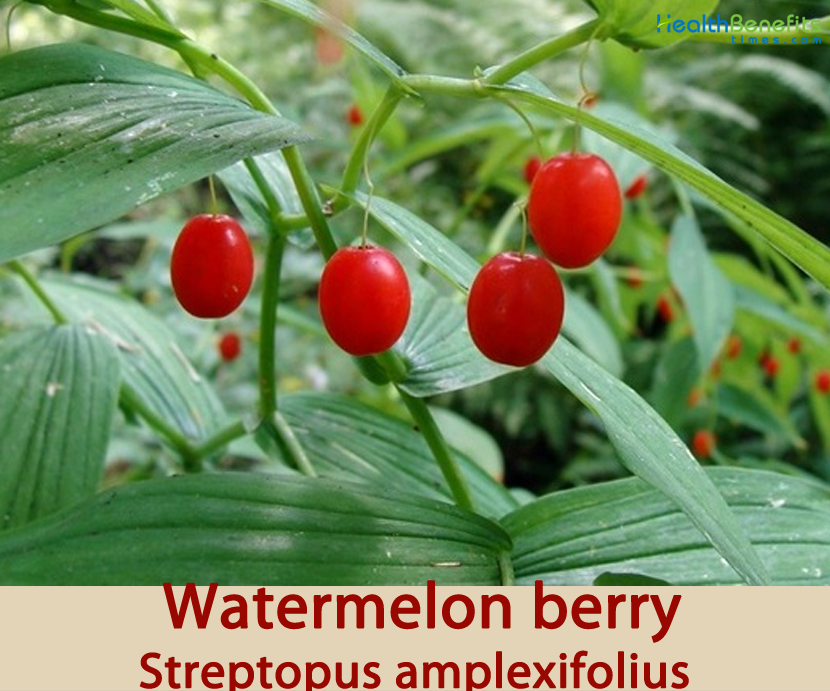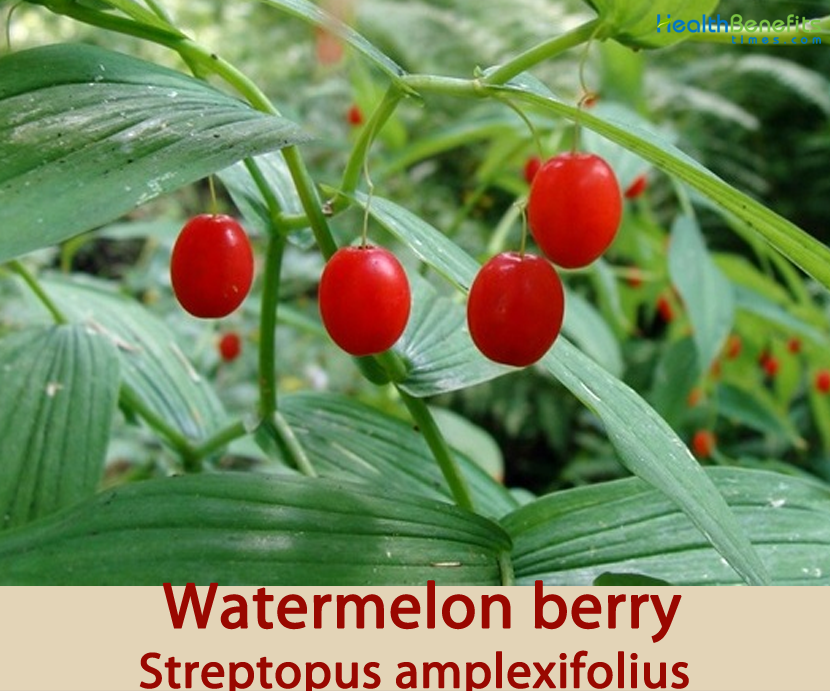| Watermelon berry Quick Facts | |
|---|---|
| Name: | Watermelon berry |
| Scientific Name: | Streptopus amplexifolius |
| Origin | Temperate areas of North America, northern Europe, and Asia |
| Colors | Light green to yellow-orange or red often becoming dark purple |
| Shapes | Edible, oval to oblong shaped berries 10-12 mm long |
| Health benefits | Support for stomach complaints, loss of appetite, spitting up of blood, kidney problems, gonorrhea and anorexia |
Streptopus is from the Greek word streptos which means twisted and podus which means foot, in reference to the bent or twisted penduncles. Specific epithet amplexifolius is from the Latin word amplexor which means to surround and folius means leaf. The name twisted stalk refers to the zig-zag stem, or to the strongly bent flower stalks. The plant is harvested from the wild for local use as a food, medicine and source of incense. It is sometimes grown as an ornamental.
Watermelon Berry Facts
| Name | Watermelon berry (Twisted Stalk) |
|---|---|
| Scientific Name | Streptopus amplexifolius |
| Native | North America (Greenland, northern United States including Alaska; and most of Canada including Yukon and Northwest Territories). It is also found in central and southern Europe (from Spain to Ukraine and as far north as Germany and Poland) and in eastern Asia (Japan, Korea, Myanmar (Burma) and eastern Russia (Yakutia, Amur, Kamchatka, Sakhalin, Kuril Islands, Khabarovsk, Primorye)) |
| Common Names | Clasp twisted stalk, Clasping twisted stalk, Cucumber-root, Twisted stalk, Clasping-leaved twisted-stalk, Clasping twisted-stalk, Liver berry, White mandarin, clasp leaf twisted-stalk, watermelon berry, white twisted-stalk, Wild Cucumber, Tubercle twisted stalk, white twisted-stalk, root, scoot berry |
| Name in Other Languages | Bulgarian: Listoobkhvashtasht streptopus (листообхващащ стрептопус) Catalan: Estrèptopus Croatian: Obuhvatni čepnjak Czech: Cípek objímavý Danish: Bugtet fjeldkonval English: Clasp twisted stalk, Clasping twistedstalk, Cucumber-root, Twisted stalk, Clasping-leaved twisted-stalk, Clasping twisted-stalk, Liverberry, White mandarin, claspleaf twisted-stalk, watermelon berry, white twisted-stalk French: Streptope à feuilles embrassantes, Sceau-de-Salomon noueux, Streptope amplexicaule, Streptope blanc, laurier alexandrin des Alpes, streptope à feuilles amplexicaules, uvulaire German: Stengelumfassender Knotenfuß, Drehfuß, Europa-Knotenfuß, Knotenfuß, Knotenstiel Hungarian: Szárölelő nyelvcsap Italian: Lauro alessandrino Japanese: Oba-takeshima-ran (オオバタケシマラン) Korean: Juk dae a jae bi (죽대아재비) Polish: Liczydło górskie Russian: Streptopus stebleob”yemlyushchiy (стрептопус стеблеобъемлющий) Serbian: Oštrelj (оштрељ) Slovak: Objímavka obyčajná Slovene: Navadni čepnjek Swedish: Skruvrams Ukrainian: Streptop listoobgortniy (Стрептоп листообгортний) Upper Sorbian: Wobjimowaca babinka |
| Plant Growth Habit | Herbaceous perennial plant |
| Growing Climates | Wet sub-alpine woods, moist woods and thickets, rich moist coniferous and deciduous woods, shady mountain forests, stream sides, seepage areas, hummocks in swamps, alpine or subalpine zones, shores of rivers or lakes, avalanche tracks, clearings |
| Soil | Grow in moist, humus-rich soil in partial shade |
| Plant Size | Grows 20 to 39 inches (50 to 100 cm) in height |
| Stem | Erect, 40– 120cm long and succulent in texture. The stems, freely branched, are bent at nodes, noticeably forming a zigzag pattern. The herbage ranges from glabrous to fairly pubescent with thick, rigid hairs on the lower third of the stems |
| Leaf | leaves are alternate along the stems and are oval to oblong-lanceolate in shape with parallel venation. Leaves are glaucous beneath and the margins are either entire or minutely toothed. They measure 5-15 cm long and 3-7 cm wide |
| Flowering season | May to July |
| Flower | Flowers are white and greenish-tinged, bell-shaped (usually single), consisting of six bell-shaped tepals 9-15 mm long. Tepals are oblong-lanceolate, concavely tapering to long, pointed, spreading or bent-back tips. The 6 stamens are of unequal length, the innermost longer than the outer stamens. Each flower has one 3-chambered pistil |
| Fruit Shape & Size | Edible, oval to oblong shaped berries 10-12 mm long |
| Fruit Color | Light green to yellow-orange or red often becoming dark purple |
| Season | September to October |
| Other Facts |
|
Plant Description
Watermelon berry (Twisted Stalk) is an herbaceous perennial plant producing a cluster of freely-branched stems from a thick, creeping rhizome. The pant normally grows about 20 to 39 inches (50 to 100 cm) in height. The plant is found growing in wet sub-alpine woods, moist woods and thickets, rich moist coniferous and deciduous woods, shady mountain forests, stream sides, seepage areas, hummocks in swamps, alpine or subalpine zones, shores of rivers or lakes, avalanche tracks and clearings. The plant grows in moist, humus-rich soil in partial shade.
Stem
The base of the leaf clasps the stem and the basal lobes nearly joined on the other side of the stem. The stem is hairless except sometimes at the base, freely branched, erect in the lower plant with branches widely spreading, and often zig-zags some between the alternately attached leaves.
Leaves
The leaves are alternate along the stems and are oval to oblong-lanceolate in shape with parallel venation. Leaves are glaucous beneath and the margins are either entire or minutely toothed. They measure 5-15 cm long and 3-7 cm wide. The stalk less leaves clasp the stem at their bases (Those of rosy twisted-stalk do not clasp the stem.). Basal leaves are lacking. The lower surface of the leaves have a dull grayish-green color covered in a waxy bloom.
Flower
The flowers droop from leaf axils, hanging on thin, sharply bent stalks from 9-15 mm long. The flower stalk is jointed and abruptly bent or kinked. They consist of a small gland at the bend. Flowers are white and greenish-tinged, bell-shaped (usually single), consisting of six bell-shaped tepals 9-15 mm long. Tepals are oblong-lanceolate, concavely tapering to long, pointed, spreading or bent-back tips. The 6 stamens are of unequal length, the innermost longer than the outer stamens. Each flower has one 3-chambered pistil. The flowers are typically hidden under the leaves and may go unseen. Flower stalks are up to 2 inches long, wiry and bent or twisted.
Fruit
Fertile flowers are followed by edible, oval to oblong shaped berries 10-12 mm long. The fruit ripens from light green to yellow-orange or red often becoming dark purple. The fruit hangs on the sharply bent stalk. Seeds are several to many per berry.
The plant’s green shoots are also edible and are said to taste similar to cucumber when consumed raw. The fruit is used in the preparation of soups and stews. The tender young shoots can be eaten raw or cooked, however, consumption of large quantities is said to act as a laxative. Thus, the common name, ‘Scoot berries’.
Traditional uses and benefits of Watermelon berry
- The fruit is cathartic.
- An infusion of the stems and fruit has been used to treat sickness in general.
- An infusion of the whole plant has been used to treat stomach complaints and loss of appetite.
- Compound infusion of the plant has been used in the treatment of spitting up of blood, kidney problems and gonorrhea.
- Root has been chewed in order to induce labor in cases of protracted delay.
- Compound infusion of the root has been used as an analgesic in the treatment of internal pain.
- An infusion of the plant has been taken for loss of appetite and stomachaches.
- The Quileute people believed that garter snakes and water snakes ate the berries.
- Juice of the berries was used as a soothing treatment for burns by American Indians.
- Fruit is a powerful purgative or laxative, causing severe evacuation.
- Compound tea has been used in the treatment of spitting up of blood, kidney problems and gonorrhea.
- Root has been used as a gynecological aid, chewed in order to induce labor in cases of protracted delay.
- The Liber Herbarum cites this herb as being a laxative, an anti-hemorrhagic and an analgesic.
- It also is reported as being good for the stomach, effective in diseases of the kidney, and sexually transmitted diseases.
- It restores appetite thus easing anorexia.
- Stems of this plant were used by the Haida for a poultice on cuts.
- Makah women chewed and ingested the root to induce labor in case of protracted delay.
Uses for foraged watermelon berries
Watermelon berries can be eaten in most of the same ways as any other wild berry, but here are some ideas on how to use them. Just keep in mind that they’re juicy, don’t have a lot of color, and do contain noticeable amounts of seeds.
Syrups, jellies & jams
Watermelon berries are the kind of berry that you’ll want to strain before making syrups, jellies or jams; otherwise the seeds will likely be a nuisance. All three of those things would be delicious with watermelon berries, though.
Breads or baked products
I’ve heard that some people bake them directly into breads or wild berry muffins and the seeds aren’t as noticeable.
Fresh berry juice or frozen treats
If you can harvest enough berries, you can also make watermelon berry juice from them (strained, of course). And whenever you’ve got juice, you can freeze it into tasty fruit pops.
Salad mix-ins
If you have a few other salad ingredients, the seeds would be add a nice texture paired with a vinaigrette dressing.
Culinary Uses
- Fruit can be consumed raw or cooked in soups and stews.
- Tender young shoots can be consumed raw in salads or cooked like asparagus.
- It is a cucumber-like flavor.
- Root can be consumed raw.
- It is sometimes used in salads for its cucumber flavor.
- Leaves have been cooked and eaten as greens.
References:
https://pfaf.org/user/plant.aspx?LatinName=Streptopus+amplexifolius
https://www.itis.gov/servlet/SingleRpt/SingleRpt?search_topic=TSN&search_value=43044#null
https://gd.eppo.int/taxon/SRWAM
https://gobotany.nativeplanttrust.org/species/streptopus/amplexifolius/
http://www.theplantlist.org/tpl1.1/record/kew-287538
https://www.wnps.org/native-plant-directory/430:streptopus-amplexifolius
https://www.fs.fed.us/wildflowers/plant-of-the-week/streptopus_amplexifolius.shtml
https://en.wikipedia.org/wiki/Streptopus_amplexifolius
https://inaturalist.ca/taxa/79273-Streptopus-amplexifolius
https://plants.usda.gov/home/plantProfile?symbol=STAM2
https://www.minnesotawildflowers.info/flower/clasping-leaved-twisted-stalk
https://gobotany.nativeplanttrust.org/species/streptopus/amplexifolius/
http://temperate.theferns.info/plant/Streptopus+amplexifolius
Comments
comments

